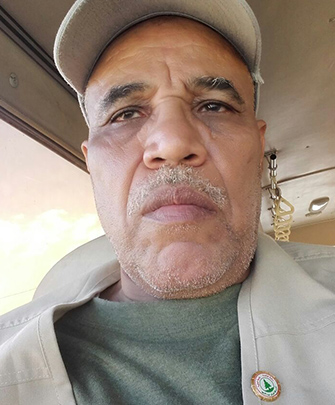Saeed Mohammad Al-Alawi

Saeed Muhammad Al-Allawi - Artist from the Fine Time
Written by Dr. Salman Al-Hajry - Sultanate of Oman
Saeed Al-Alawi with its curved and winding lines to the top as if it were the veins of the Hijaz palm trees, which Saeed reduces from the subconscious mind as a true and sincere reflection of the spirit that can be presented to us by a beautiful work that carries a wonderful identity sometimes with degrees of blue that are a reflection of something of memory, and sometimes with earthy colors that reflect its connection with the earth On which he grew up and became a master
He has a permanent icon, from which he looks to further horizons.
In this article I try to record my admiration for the beautiful art produced by the fingertips of this true artist
The artist Saeed Al-Alawi possesses many plastic components that make him a successful plastic artist. The most important of these elements is honesty in presentation and automaticity in expression and the constant pursuit of compatibility between the past and the present.
Honestly, the artist can retrieve his subjects spontaneously and put them up directly without thinking and scrutinizing. Honesty here is the conscious mind that defines the subject to be drawn, and honesty here is the unconscious that defines the features and elements of this topic and honesty also are the fingers that select the appropriate colors for the presentation when spontaneous appear to determine the direction of lines and extent Its refraction, softness, and inclination. As for spontaneity in expression, it is the bridge through which the artist’s shipments pass through to reach the whiteness of the surface of the painting.
Al-Alawi redraws the memory related windows, doors and mashrabiya that listens to his memory by listening to her other than Abe, because of the elements and symbols that may arouse his interest in contemporary art promoted by many artists.
Here, he insists on his symbols, and he insists on launching them from inside, turning them into doves, which push them to fly whenever he feels his need for painting, so he lands on the work surface as it is without frills.
As for Allawi's ability to reconcile between the past and the present, he is his constant obsession and his way of formation, as the viewer of his works feels at first glance that they are modern and contiguous color spaces in which there is a lot of chromatic wealth and at the same time contain many images and heritage and popular symbols as the color hormonal has been distributed by the artist in a deliberate design manner sometimes You find it places the color and meets it in its complement, sometimes it color its main axes with a hot color in order to stimulate the eye and stimulate it on it. At the same time, it gives the back areas a bit of transparent cold colors that may push the rest of the elements forward and emphasize it.
In addition to the previous elements, the Alawi artist is a persistent artist who has a vision that has its presence in the Gulf and Arab arena. His vision revolves around the Islamic plastic identity. He always asks how, when and where can the Muslim artist present his issues, ideas and visions to the other without the use of imported methods and repeated language ??
Here, the art of art that is stained with an Islamic identity becomes an urgent necessity and an inevitable fate of the artist Saeed Al-Alawi.
And while adhering to the Islamic plastic identity, the artist Saeed Al-Alawi insists on renewing and innovating in his paintings, as the color combinations that he presents from time to time and finding new solutions for the painting perspective are considered as new blood that the artist pumps in his paintings in order to enjoy the recipient and draw his attention with calm and calm to convince him of the aesthetic vocabulary so that the idea is linked to the mind The receiver is longer, especially because it has been accompanied by striking aesthetic symbols.
So, the Alawi artist possesses his plastic tools (the elements of formation) well and has the ability to use them according to design rules that do not burden him, on the training side, it seems that Saeed Al Alawi tends to vertical formation using most of the time the vertical straight lines and winding from the base of work to the top and it is known that Vertical lines are lines that give an indication of stability and firmness. That artist, when drawing the old houses, and artistic intelligence, helped Saeed insist on drawing these lines and assembling them in the middle of the painting, stressing in the middle of the work as a axis that reduces the eye and forces it to reflect on the components of the work and at the same time enjoy the transparency of the adjacent color spaces and framed for many Of his works.
Allawi continues to use his tools with some skill, and this is evident when distributing dark blocks and bright areas in his works, so he finds them well distributed, attracting the eye so that he does not abundant of opaque blocks, alienating the eye, and not too much of the conquerors, so his works lose the required contrast, and on the other hand raises the eyes of the connoisseurs for his work With the various and rich touches, the texture of the walls that he draws differs from that of windows or other areas, and differs according to the emotional state he is going through when he draws his ability to use and distribute colors. It is a summary of the whole color theory, and this is indicated in his ability to use colors in certain places, for example, when he draws a color on one side We find it with a complement to this color on the other side, and when they color the basic elements with hot colors, we find that it draws its backgrounds in cool colors or with less color saturation, and Saeed Al Allawi prefers to work with specific colors (with one pallet). He chose it with a bit of caution, using his ability to find color harmonic services that serve the topic that he would like to present in Many of Jeddah's old lane paintings, we find it uses earthy colors to paint homes, windows, mashrabiya and turquoise. Blue background representing sky and horizon.
All of this plastic engineering in harnessing the plastic tools like calligraphy, texture, color, etc., enabled Saeed Al-Alawi to obtain aesthetic values that are interesting to the eye and attractive as the melody that he frequently repeats when drawing for the Hijazi decorative units that he scatters from the top sometimes in the form of gradient triangles in size that are spouted in the middle of the painting sometimes In the form of (Islamic miniatures) Fade in the space of the painting component 'melody and music exciting for the eye almost uttered Hijazi rhythms have its own impact on the eye and these tools also helped him to find the balance required in most of his works a balance not Balmestri but a balance dependent on the distribution of dark and luminous blocks and the distribution of colors.
In front of the paintings of the artist Saeed Al-Alawi, the eye becomes able to listen to the tune of the Arab-Islamic identity, and the ear becomes able to see the fine details of the heritage of the Hijaz Al-Talid. We definitely prove to us that the artist Saeed Al-Alawi is an artist from a transparent time.

